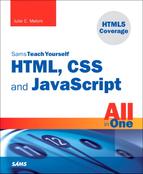Table of Contents
CHAPTER 1: Publishing Web Content
A Brief History of HTML and the World Wide Web
Understanding Web Content Delivery
Selecting a Web Hosting Provider
Testing with Multiple Web Browsers
Distributing Content Without a Web Server
CHAPTER 2: Understanding HTML and XHTML Connections
Getting Started with a Simple Web Page
HTML Tags Every XHTML Web Page Must Have
Organizing a Page with Paragraphs and Line Breaks
Organizing Your Content with Headings
The Scoop on HTML, XML, XHTML, and HTML5
CHAPTER 3: Understanding Cascading Style Sheets
Internal Style Sheets and Inline Styles
CHAPTER 4: Understanding JavaScript
How JavaScript Fits into a Web Page
Exploring JavaScript’s Capabilities
Displaying Time with JavaScript
Adding the Script to a Web Page
CHAPTER 5: Working with Fonts, Text Blocks, and Lists
Boldface, Italics, and Special Text Formatting
Working with Special Characters
CHAPTER 6: Using Tables to Display Information
Alignment and Spanning Within Tables
CHAPTER 7: Using External and Internal Links
Linking Within a Page Using Anchors
Linking Between Your Own Web Content
Linking to External Web Content
Opening a Link in a New Browser Window
CHAPTER 8: Working with Colors, Images, and Multimedia
Best Practices for Choosing Colors
Using Hexadecimal Values for Colors
Using CSS to Set Background, Text, and Border Colors
The Least You Need to Know About Graphics
Reducing the Number of Colors in an Image
Working with Transparent Images
Creating Animated Web Graphics
Specifying Image Height and Width
Integrating Multimedia into Your Website
CHAPTER 9: Working with Margins, Padding, Alignment, and Floating
Understanding the Float Property
CHAPTER 10: Understanding the CSS Box Model and Positioning
The Whole Scoop on Positioning
Controlling the Way Things Stack Up
CHAPTER 11: Using CSS to Do More with Lists, Text, and Navigation
How the CSS Box Model Affects Lists
Creating Image Maps with List Items and CSS
How Navigation Lists Differ from Regular Lists
Creating Vertical Navigation with CSS
Creating Horizontal Navigation with CSS
CHAPTER 12: Creating Fixed or Liquid Layouts
Creating a Fixed/Liquid Hybrid Layout
CHAPTER 13: Understanding Dynamic Websites
Understanding the Different Types of Scripting
Understanding the Document Object Model
Changing Images Based on User Interaction
CHAPTER 14: Getting Started with JavaScript Programming
CHAPTER 15: Working with the Document Object Model (DOM)
Understanding the Document Object Model (DOM)
Working with the document Object
Working with the location Object
Creating Positionable Elements (Layers)
CHAPTER 16: Using JavaScript Variables, Strings, and Arrays
Understanding Expressions and Operators
CHAPTER 17: Using JavaScript Functions and Objects
Using Objects to Simplify Scripting
CHAPTER 18: Controlling Flow with Conditions and Loops
Using Shorthand Conditional Expressions
Testing Multiple Conditions with if and else
Using Multiple Conditions with switch
Looping Through Object Properties
CHAPTER 19: Responding to Events
Using the onLoad and onUnload Events
Using onclick to Change <div> Appearance
CHAPTER 20: Using Windows and Frames
Controlling Windows with Objects
Linking Between Frames and Windows
CHAPTER 21: Using Unobtrusive JavaScript
Supporting Non-JavaScript Browsers
CHAPTER 22: Using Third-Party Libraries
CHAPTER 23: Greasemonkey: Enhancing the Web with JavaScript
Creating Your Own User Scripts
CHAPTER 24: AJAX: Remote Scripting
Creating a Simple AJAX Library
Creating an AJAX Quiz Using the Library
CHAPTER 25: Creating Print-Friendly Web Pages
What Makes a Page Print-Friendly?
Applying a Media-Specific Style Sheet
Designing a Style Sheet for Print Pages
Viewing a Web Page in Print Preview
CHAPTER 26: Working with Web-Based Forms
Naming Each Piece of Form Data
Accessing Form Elements with JavaScript
CHAPTER 27: Organizing and Managing a Website
Thinking About Version Control
CHAPTER 28: Helping People Find Your Web Pages
Listing Your Pages with the Major Search Sites
Providing Hints for Search Engines
